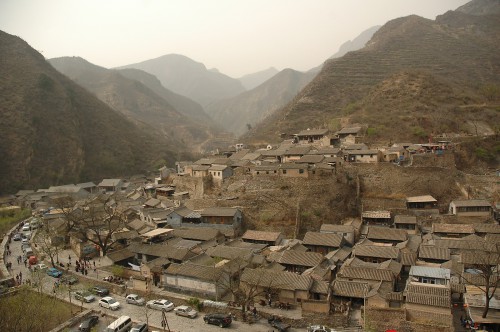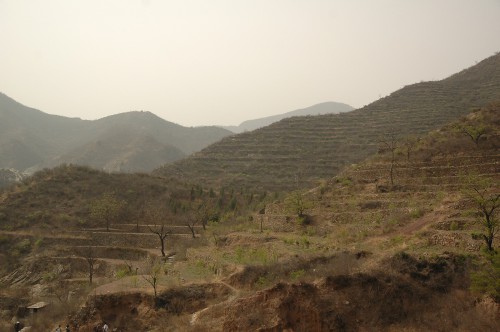In Europe a very important part of planning one’s vacation are the bridge days. Especially in May there are plenty of those. Even if not leaving home or traveling far, one likes to take one day of in order to have a long weekend with one’s loved ones. However in China there is no such thing as bridge days. The Chinese just move the weekend in order to close the gap between the days off. It thus happened this year that the weekend just before May 1st was moved to Sunday and Monday and people had a six day workweek leading up to the holiday. We decided to make use of the holiday by discovering a small village in the mountains West of 北京 (bei jing). An adventure!
Looking for places to go on a day trip I came across the mountain village of 川底下村 (chuan di xia), about 80km to the West of Beijing. A traditional mountain village, very well hidden. Since we live in the East of the capital it was quite a trip to make it to this village, we expected about three and a half hours. The trip was the most adventurous part of the day, no matter which direction.
First we took the Beijing metro to 苹果园 (ping guo yuan), the terminus station of the subway line 1. From there we should be able to reach 川底下村 either by bus or taxi. While I was waiting for Lenka near the subway station I was approached by a first taxi driver. He immediately asked me where I was headed and whether I needed a ride. In order to find out about the pricing I told him where we were headed and was not surprised that he asked for a very high price. Since there was also a bus headed to the village there was no need to negotiate too hard, but once Lenka was back, we headed towards the bus stop for line 892. We again were approached by a driver and I finally got the price I wanted for a trip to 川底下村, but only one way. We were not worried that we could find a ride back on either another taxi or a bus.
We left 苹果园, but already after a few minutes the driver turned off the main road one headed for some small side roads even he didn’t know. Apparently there was an accident on the main road and of course a big traffic jam ensued. Somehow the driver managed to find his way across the river and back to the main road G109, which we followed almost all the way to 川底下村. Die mountains west of the capital seem to be very popular with the locals, since the road was jammed with lots of cards headed for the mountains. Since the driver was quite in a hurry, we were glad to have a seat in the very back of the minivan, such that we had a maximum crush zone. The passing maneuvers were more than risky. But eventually we made it to 川底下村 and the driver organized the entry tickets for us, before dropping us off near the village.
The village consists of small houses built from rock, between which narrow streets lead up and across the village. The houses typically have a very nice courtyard, which are almost exclusively used as restaurants these days. We appreciated this fact very much, since we had arrived around lunch time and were quite hungry. Once again we had a delicious Chinese meal, this time consisting of fried flowers, grilled innards of chicken, a spinach salad and a bowl of bean rice for each. After the negotiation with the drivers I had my second success in speaking with the Chinese. It is definitely worth it learning Mandarin.
After lunch we took a walk around the village and visited the temple of the village’s saint. The great weather had brought quite a few tourists into the village, but with respect to China, the amount of people was not too much. One of the reasons was the fact, that there were a few more small sights scattered outside the village, which could be visited on foot. Another particularity of the village are the terraces on the slopes surrounding the village. In earlier days the were used for farming, but have lost their use some time again, when tourism picked up in the area. The terraces are overgrown with weeds and small bush. They don’t look anything alike the rice terraces in Southern China. The people here however prefer catering to the tourists instead of working in the fields. Almost no house does not sport a sign inviting guest in for a meal.
After our walk in and around the village, we found a shared taxi, which brought us to Beijing in an amazing speed. We constantly passed a waiting line of cars on the other line, took a newly built, unfinished highway and criss-crossed through small roads in villages. Glad to be back in è<¹æzoeå>, we got off the minivan and headed for the subway station. Since we could get on the subway at the terminus station, we had the rare honor of heaving a seat in the subway line 1. We arrived home at dusk.
The trip was definitely worth it, however one has to be aware of the time it takes to reach the small village. It would be worth considering staying in or around 川底下村 overnight and spending two days in the area. There are plenty of places to walk to from the village. Additionally there would certainly be less people in the early morning or later in the evening. We consider shared taxis being the best way of traveling to 川底下村 from 苹果园, which should cost around 25RMB per person. The taxi driver’s initial price was 500RMB for a return trip including waiting time. The ride on the bus line 892 (the line 929, which is still indicated in many places does not run to 川底下村 anymore) should cost 10RMB, but takes longer than the shared taxi, since there are apparently 39 stops for the bus.




